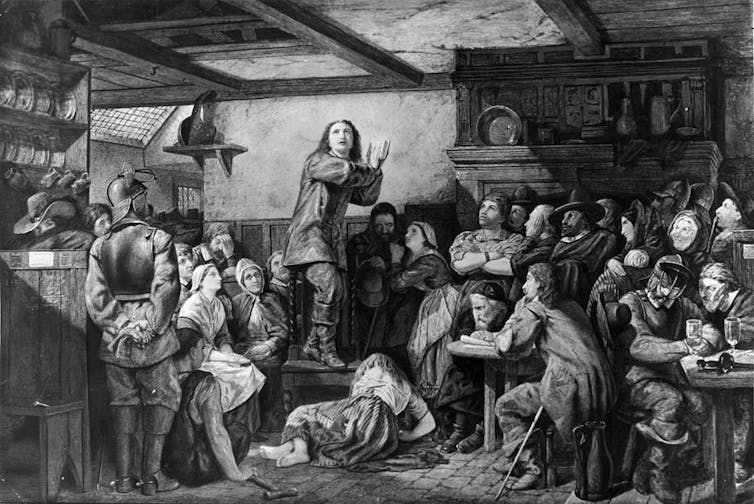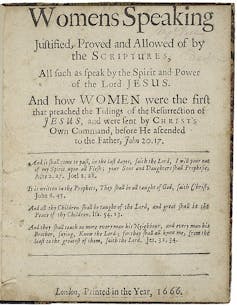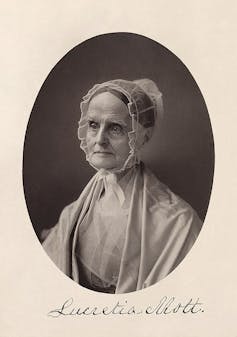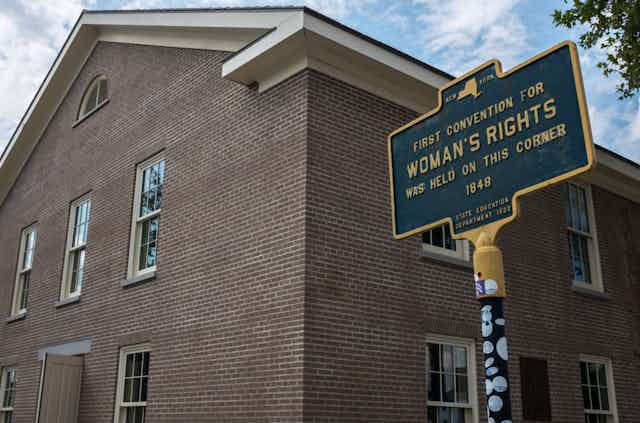On July 19, 1848, nearly 300 men and women gathered in Seneca Falls, New York, to begin the United States’ first public political meeting regarding women’s rights. The Seneca Falls Convention resulted in the Declaration of Sentiments, a document modeled on the U.S. Declaration of Independence that asserted “all men and women are created equal.”
The two-day conference marked the beginning of the movement for women’s suffrage, which would be granted 70 years later by the ratification of the 19th Amendment of the Constitution. And it likely wouldn’t have happened without Quakers.
Four of the convention’s five leaders belonged to this Protestant Christian group, also known as the Religious Society of Friends, whose ideas and community deeply shaped the meeting. One of Quakers’ core beliefs is that all men and women possess the “inward light” – the light of Christ – and are therefore equal in the eyes of God. This belief led Quakers to recognize women as spiritual leaders, distinguishing them from many other religious groups at the time.
The Quaker women who participated in the gathering at Seneca Falls had been nurtured in a religious community that historian Nancy Hewitt describes as a “rich female world of faith, family, and friendship” – one that led many of them to step into the public sphere and work for social reforms.
As a scholar of 19th century Quaker history, I have found the faith’s women at the forefront of efforts to abolish slavery, promote the temperance movement and grant rights to women.
Women’s souls and service
Quakerism developed in the 1640s, amid the English Civil War – a time of political and religious turmoil. George Fox, one of the faith’s founders, spent much of the decade in spiritual wanderings, which led him to conclude the answers he sought came from his direct experience of God. As Quaker historian and theologian Ben Pink Dandelion notes, “This intimacy with Christ, this relationship of direct revelation,” has defined Quakerism ever since.

The belief in the “inward light” led Fox and others to encourage women’s spiritual leadership. In Fox’s later writings, he recalled encountering a religious group who believed women had no souls, “no more than a goose.” Fox objected, reminding them of Mary’s words in the Bible after an angel tells her that she will give birth to God’s son: “My soul doth magnify the Lord, and my spirit hath rejoiced in God my Saviour.”
Margaret Fell, the wife of a wealthy and prominent judge, helped Fox organize his followers into the Society of Friends. Worship meetings took inspiration from the Bible’s Book of Matthew: “For where two or three are gathered together in my name, there am I in the midst of them.” Quakers worshipped in silence. On occasion, when a worshipper felt moved by the spirit of Christ, they would break the silence to share something with the rest.
Quakers also established meetings to oversee church business, such as approving marriages, recording births and deaths, and enforcing the faith’s discipline.
Spreading the faith
Quaker men and women sometimes met together, and sometimes in separate meetings. Fox believed women might be reluctant to speak up in the company of men, even though they were men’s spiritual equals.
In their business meetings, Quaker women oversaw relief for the poor, appointed committees to visit women who had strayed from church teachings, and testified on spiritual and social concerns. One woman was selected to serve as a clerk, taking notes on members’ concerns and decisions.

Quakerism attracted a significant number of female converts, some of whom took an active role in spreading the faith. Eleven of the so-called “valiant sixty” – itinerant ministers who preached Quaker principles in several countries – were women. Elizabeth Hooton, long reputed to be Fox’s first convert, traveled widely in Britain, North America and the Caribbean, preaching and proselytizing. Mary Fisher joined six other Quakers on a spiritual visit to the Ottoman Empire in 1658, where she reported meeting with Sultan Mehmed IV.
Women also produced some of the earliest texts of Quaker witness, writing about their relationship to God. In 1666, Fell penned the pamphlet “Women’s Speaking Justified,” a scripture-based argument for the spiritual equality of the sexes. Her text is now recognized as a major 17th century document on women’s religious leadership.
Acting on faith
The Quaker women who organized the Seneca Falls Convention were born into this world of female ministry. For women like Philadelphia Quaker Lucretia Mott, one of the Seneca Falls Convention’s organizers, Quaker practice normalized the idea that women, too, should have education, religious authority and the right to speak freely. Mott was also active in the antislavery movement, boycotting slave-labor goods such as cotton and sugar and organizing women in associations like the Philadelphia Female Anti-Slavery Society.
Indeed, Quakers’ commitment to equality and community led many men and women to become social activists – but not without controversy. In the 1820s and again in the 1840s, the Society of Friends experienced a series of divisions over Quakers’ involvement in the antislavery movement and other reforms. Some saw activism as a natural manifestation of Quaker beliefs, but others feared that it threatened the group’s spiritual unity.
In 1848 – the same year as the Seneca Falls Convention – 200 Quakers made the decision to break from their yearly meeting, their local association. Citing their “rights of conscience,” these men and women later formed the Yearly Meeting of Congregational Friends. Congregational Friends believed their faith required them to take steps toward abolishing slavery, and many also felt compelled to seek rights for women.
‘Simply human rights’
Just weeks after the Quaker split, Mott joined with four other women – her sister Martha Wright, Jane Hunt, Mary Ann M’Clintock and Elizabeth Cady Stanton – to organize a women’s rights convention. Among them, Stanton was the only non-Quaker. She and Mott had met during the World’s Anti-Slavery Convention in 1848, held in London, where British organizers refused to recognize the American female delegates because of their gender.

Although the women agreed on the necessity of a women’s rights convention, they disagreed on the form and content. At their initial meeting, the five proposed to discuss the “social, civil, and religious condition of women” – placing women’s oppression within a larger constellation of social evils. Stanton, however, listed the lack of suffrage as woman’s most urgent grievance.
Ultimately, the Seneca Falls Convention produced the Declaration of Sentiments, which celebrated women’s worthiness, criticized their subjugation and articulated the rights they deserved. Participants also passed 12 resolutions designed to provide for women’s equality, affirming their right to occupy “such a station in society” as their “conscience shall dictate,” and their “sacred right to the elective franchise.”
The Quaker influence on the convention is most apparent in the differing views held by its two most influential leaders, Stanton and Mott. Stanton rejected the need to introduce other issues into the fight for women’s rights, believing that once women gained political and legal power, more reforms would follow.
Mott, on the other hand, saw women’s oppression as one of many threats to individual liberty, from slavery and abusive prisons to the treatment of Native Americans. Real change, she believed, would require going to the root of the problem: “mindless tradition and savage greed.” As Mott would later note, “Among Quakers there had never been any talk of woman’s rights – it was simply human rights.”

